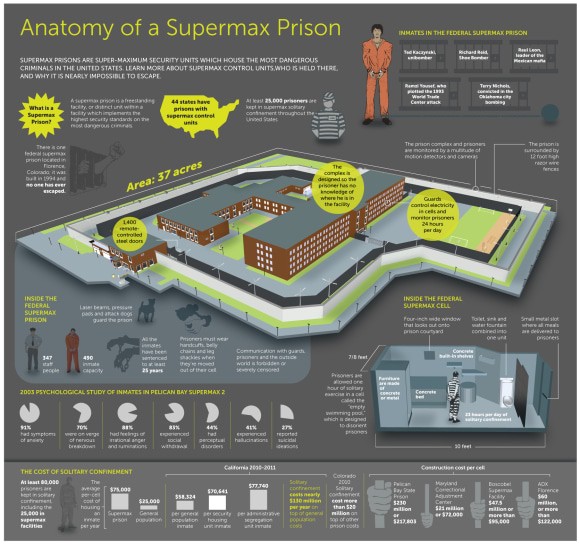 No one knows what freedom feels like more than the inmates of a Federal Supermax prison, who have none. What most people take for granted as mundane everyday tasks – simple things like making coffee in the morning, feeding the cat, filling up the gas tank and waiting in line at the bank – are the stuff of fantasies of those in Supermax prisons. After conviction, these men spend the rest of their lives boxed in by steel walls, their communication with the outside world shut off entirely. But it’s not easy to end up here. The criminal justice system does not throw anyone into such desolate conditions. To be admitted, the crime must seriously infringe upon the freedom of others.
No one knows what freedom feels like more than the inmates of a Federal Supermax prison, who have none. What most people take for granted as mundane everyday tasks – simple things like making coffee in the morning, feeding the cat, filling up the gas tank and waiting in line at the bank – are the stuff of fantasies of those in Supermax prisons. After conviction, these men spend the rest of their lives boxed in by steel walls, their communication with the outside world shut off entirely. But it’s not easy to end up here. The criminal justice system does not throw anyone into such desolate conditions. To be admitted, the crime must seriously infringe upon the freedom of others.
What Is A Federal Supermax Prison?
Approximately 25,000 inmates in the United States spend their days in the most extreme state of non-freedom known to the West. A Federal Supermax Prison, short for super-maximum security, is a prison, or section of a prison, that is reserved for only the most dangerous criminals. It is a highly guarded containment facility in which each prisoner is kept in a single, tiny steel unit and only taken out for a solitary hour of exercise each day. That’s 23 hours of solitary confinement every day for a minimum of 25 years. They eat their meals alone, pushed through a slot in the door, they exercise alone and they are allowed absolutely no contact with the outside world. The infographic below gives a detailed visual of the “home” of these prisoners, along with many grim facts about the reality of prison life. As you can see, the cell does not look inviting and it does not look comfortable. Freedom may only exist in memories and fantasies for these men, but could they tell you what it means in their dreams? Absolutely.
How Did They Get There?
Such highly contained and segregated prison units are determined fit only for the “worst of the worst.” Inmates kept in these extremely isolated, cold and lonely cells are deemed high-risk prisoners who pose a threat to national or international security. They are generally not white collar thieves, robbers or drug dealers; these are dangerous mass murderers who would kill again given the chance. Thus, they are not allowed any contact with other people. By contrast, medium- and low-risk prison facilities may still separate prisoners from each other, but not to the extreme degree of those souls in permanent solitary confinement.
Who Are They?
You have probably heard of or seen TV reenactments of the infamous men kept in Supermax prisons. One thing they all have in common? Pervasive plans to murder, destroy or harm mass amounts of people without remorse. Ted Kazcynski, more commonly known as the “Unabomber,” made headlines in the 1990s for his covert mail bombings, which killed three people and harmed dozens. This particular domestic terrorism was based on his belief that he needed to call a revolution against our modern technological society. He does not believe he is insane, and pleaded guilty to life in prison without possibility of parole. Who else makes the cut? Terrorists are at the top of the list for Supermax prisons. Richard Reid is another man who harbors nefarious plans to destroy, this time in the name of Al-Queda. More commonly referred to as the “shoe bomber” because he tried to blow up an airplane using explosives hidden in his shoes, Reid also faces a sentence of life in prison without any chance of parole. Raul Leon, leader of the Mexican mafia, spends his days in solitary confinement, along with Ramzi Yousef, mastermind of the 1993 World Trade Center attack, and Terry Nichols, accomplice in the Oklahoma City bombings. As you can see, Federal Supermax prisons are not simply for your Average Joe Criminal. Those unfortunate enough to be locked in one of these steel cages have committed heinous crimes against humanity, and would continue to do so if set free. Florence, Colorado houses the only complete Supermax prison in the U.S., though there are solitary confinement units within regular prisons throughout the country. Built in 1994, no one has ever escaped.
Criminal Justice
For these prisoners, freedom is something of the past. But for their victims and would-be victims, freedom has been preserved and upheld. Inmates like the Unabomber may have had their freedom of movement stripped of them, but such extreme punitive measures are only a result of their unashamed infringement on the rights and freedoms of others. Most everyone would agree that criminal justice has been employed, as these men are now incapable of causing harm to anyone but themselves. The dreams of prisoners in Supermax facilities may consist of anything from savoring a home cooked meal to planning their next attack strategy, but one thing is for sure: the worst prisons are reserved only for the worst criminals, and they will do neither ever again. 



